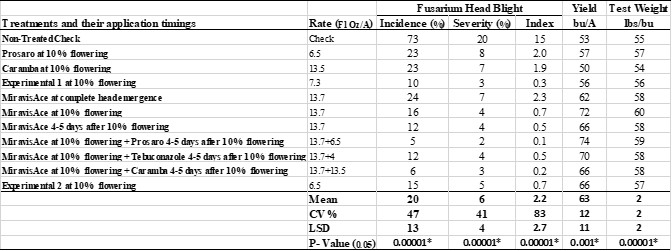Objective:
To evaluate the efficacy of fungicides at different application timings to manage Fusarium head blight in Hard Red Spring Wheat (HRSW).
Methods:
Location: NDSU Langdon Research Extension Center
Experimental design: Randomized complete block, replicated four times.
Previous crop: Canola
Cultivars of HRSW tested: WB Mayville
Planting: 1.5 million pure live seeds/acre planted on May 20, 2020. A border plot was planted between treated plots to minimize interference from spray drift.
Plot size: Seven rows at six inch spacing, 5 ft. x 20 ft., mowed back to 5 ft. x 16 ft.
Herbicides applied: Axial XL (16.4 oz/A) + Huskie (13 oz/A) applied on June 17, 2020.
Inoculation: Plots were inoculated by spreading corn spawn inoculum at approximately boot stage (Feekes 9-10) at the rate of 300 g/plot.
Disease development: Supplemental moisture was provided by running overhead irrigation from booting to soft dough stage at the rate of one hour per day to create a conducive environment for FHB development.
Fungicide treatments: Fungicides were applied with a CO2-pressurized backpack sprayer with a three nozzle boom (XR-8002) and the water volume used was 20 GPA. Fungicide (Miravis Ace) application was made at full head emergence on July 2nd. Miravis Ace, Prosaro and Caramba were applied at 10% flowering (anthesis) on July 6th and repeated 5 days after the first spray (July 11th). Refer to Table 1 for the treatments, rates and application timings.
Disease assessment: Data on FHB incidence was obtained by counting the number of heads showing FHB symptoms out of 50 heads at hard dough stage. FHB head severity was rated using 0-100% scale on arbitrary 50 heads, excluding two outer rows. FHB index (Index) was calculated using formula: Index = (SEV*INC)/100.
Harvest: Plots were harvested on September 2nd with a small plot combine and the yield was determined at 13.5% moisture.
Data analysis: Statistical analysis was done using Agrobase Generation II software. Fisher’s least significant difference (LSD) was used to compare means at p (α = 0.05). Means were presented in the table for simplicity of understanding.
Table 1: Efficacy of fungicides at various application timings to manage Fusarium Head Blight on Hard Red Spring Wheat.
* Indicates treatments are statistically significant.
Note: All treatments were applied with NIS @ 0.125 v/v.
Results: All the fungicide treatments at different application timings were statistically significant from that of the non-treated check among the variables tested except yield. Application of Miravis Ace at 10% flowering plus Prosaro 4-5 days after 10% flowering was the best treatment (Table 1).
Funded by: US Wheat and Barley Scab Initiative Project.
